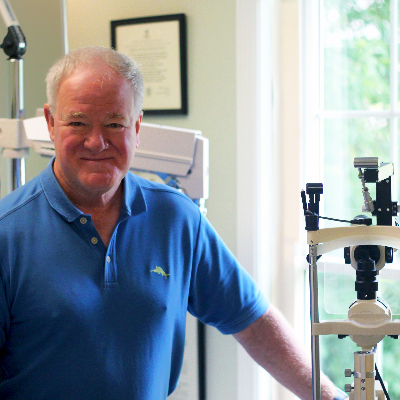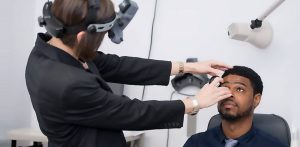Ocular hypertension — high pressure inside the eyes — is not just a number but can have serious consequences.
What is ocular hypertension?
When the fluid in the eyes doesn’t drain properly, pressure builds up inside the eye. This higher than normal pressure is called ‘ocular hypertension’.
Ocular hypertension can lead to sight-threatening health concerns and needs to be closely monitored by your eye doctor.
There are many complications of high eye pressure:
1. Glaucoma
Glaucoma impacts the lives of over 12% of the population, can result in ‘tunnel vision’ and is known as the ‘Silent Thief of Sight’.
One of the main risk factors for glaucoma is elevated intraocular pressure, which is a concern in people with ocular hypertension.
Glaucoma is an ocular disease that causes vision loss from damage to the optic nerve, which is responsible for carrying visual signals between the eye and brain.
Glaucoma: the “Silent Thief of Sight”
This nickname is well deserved as glaucoma causes vision loss before the person notices any symptoms.
Glaucoma has the infamous reputation of “robbing” the ability to see, without giving the person time to recognize symptoms and seek their eye doctor’s medical opinion. Consequently, a diagnosis is usually made only after permanent vision loss has occurred.
It is therefore important to schedule regular eye exams, as new diagnostic tests are available to detect early signs of glaucoma, and are essential in preventing vision loss.
2. Optic nerve damage
Having high pressure inside your eye can heighten your risk of developing permanent nerve damage.
High eye pressure increases your risk for developing conditions such as optic neuritis and glaucoma.
SEE RELATED: 6 Tips for Healthy Eyes after 50
Schedule an appointment with an eye doctor near you to have your eye pressure measured.
3. Vision loss
The front of the eye contains a fluid called the aqueous humor. This fluid is essential to nourish eye tissue while also assisting in maintaining the eye’s shape.
Since aqueous humor is in constant production, a healthy drainage system is essential for maintaining normal eye pressure levels. If aqueous humor is unable to drain properly, it builds up. This increases the pressure inside the eye, resulting in ocular hypertension.
If left untreated, it can lead to optic nerve damage and vision loss.
Signs of high eye pressure
Ocular hypertension typically doesn’t show any noticeable signs or symptoms at first.
It’s common to develop ocular hypertension without realizing it.
Unfortunately, there are often no obvious signs of high eye pressure until permanent damage has occurred. This makes visiting your eye doctor for regular eye exams essential.
During a comprehensive eye exam, your eye doctor will measure your eye pressure to ensure it falls within a normal range.
Is there a cure for ocular hypertension?
Scientists have yet to discover a cure for high eye pressure.
However, with careful monitoring and treatment, you can decrease your risk of sight-threatening complications.
Prescription eye drops are often used to treat ocular hypertension. They can either help aqueous fluid drain from your eye or reduce the amount of aqueous humor produced by your eye.
In some cases, surgery may be necessary.to improve aqueous fluid drainage from the eye. This can be done with a laser or with more traditional surgical methods.
LEARN MORE: Guide to Eye Health
Contact an eye doctor near you who can diagnose and treat ocular hypertension.
Ocular hypertension is high pressure inside your eyes. It can lead to sight-threatening health concerns and needs to be closely monitored by your eye doctor.









